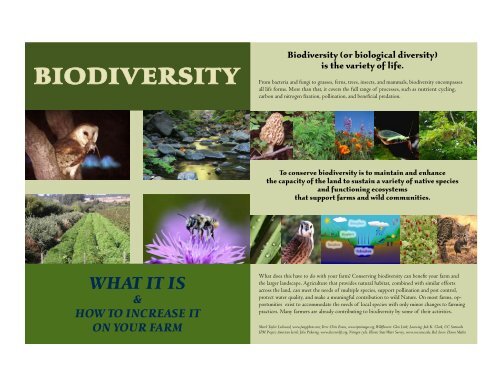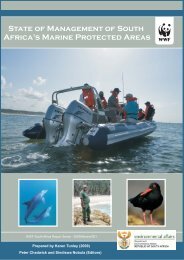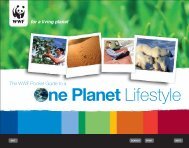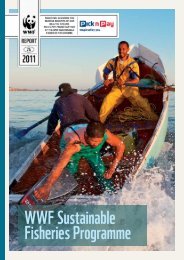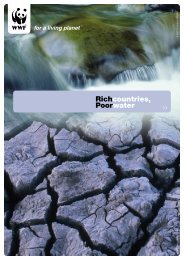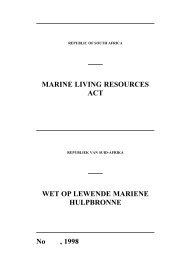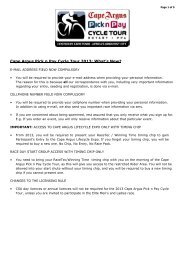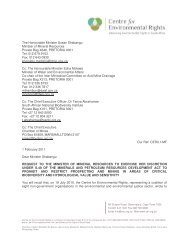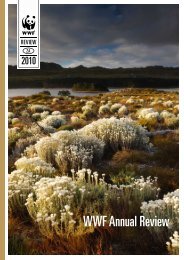Biodiversity on the farm
Biodiversity on the farm
Biodiversity on the farm
Create successful ePaper yourself
Turn your PDF publications into a flip-book with our unique Google optimized e-Paper software.
BIODIVERSITY<str<strong>on</strong>g>Biodiversity</str<strong>on</strong>g> (or biological diversity)is <strong>the</strong> variety of life.From bacteria and fungi to grasses, ferns, trees, insects, and mammals, biodiversity encompassesall life forms. More than that, it covers <strong>the</strong> full range of processes, such as nutrient cycling,carb<strong>on</strong> and nitrogen fixati<strong>on</strong>, pollinati<strong>on</strong>, and beneficial predati<strong>on</strong>.To c<strong>on</strong>serve biodiversity is to maintain and enhance<strong>the</strong> capacity of <strong>the</strong> land to sustain a variety of native speciesand functi<strong>on</strong>ing ecosystemsthat support <strong>farm</strong>s and wild communities.&WHAT IT IS&HOW TO INCREASE ITON YOUR FARMWhat does this have to do with your <strong>farm</strong>? C<strong>on</strong>serving biodiversity can benefit your <strong>farm</strong> and<strong>the</strong> larger landscape. Agriculture that provides natural habitat, combined with similar effortsacross <strong>the</strong> land, can meet <strong>the</strong> needs of multiple species, support pollinati<strong>on</strong> and pest c<strong>on</strong>trol,protect water quality, and make a meaningful c<strong>on</strong>tributi<strong>on</strong> to wild Nature. On most <strong>farm</strong>s, opportunitiesexist to accommodate <strong>the</strong> needs of local species with <strong>on</strong>ly minor changes to <strong>farm</strong>ingpractices. Many <strong>farm</strong>ers are already c<strong>on</strong>tributing to biodiversity by some of <strong>the</strong>ir activities.Morel: Taylor Lockwood, www.fungiphoto.com; Fern: Chris Evans, www.ipmimages.org; Wildflowers: Glen Little; Lacewing: Jack K. Clark, UC StatewideIPM Project; American kesrel: John Pickering, www.discoverlife.org; Nitrogen cycle: Illinois State Water Survey, www.sws.uiuc.edu; Red clover: Dawn Ma<strong>the</strong>s
A Farm Is Not an IslandPicture your property in a larger c<strong>on</strong>text of <strong>the</strong> surrounding landscape.Think of <strong>the</strong> way water flows through your land, <strong>the</strong> routes wildlifetake, and <strong>the</strong> c<strong>on</strong>necti<strong>on</strong>s to your neighbors’ properties and wildlandsbey<strong>on</strong>d. Learn about what c<strong>on</strong>diti<strong>on</strong>s local species are adapted to, andwhat ecosystems historically occupied <strong>the</strong> <strong>farm</strong>. Habitat c<strong>on</strong>servati<strong>on</strong>can ensure clean water leaves your land, and can provide a stopover formigratory birds and movement corridors for wildlife. After all, water,species and habitats do not follow property lines.Work with Supportive Organizati<strong>on</strong>s• Wild Farm Alliance www.wild<strong>farm</strong>alliance.org• Community Alliance with Family Farmers www.caff.org• Audub<strong>on</strong> California. Land Stewardship Programwww.Audub<strong>on</strong>-ca.org/LSP/Willow_Slough.htm• Defenders of Wildlife www.biodiversitypartners.org• Nati<strong>on</strong>al Center for Appropriate Technology www.ncat.org• Natural Resources C<strong>on</strong>servati<strong>on</strong> Service www.nrcs.usda.gov• Resource C<strong>on</strong>servati<strong>on</strong> Districts of Californiawww.nacdnet.org/resources/CA.htm• U.C. Sustainable Agriculture Research and Educati<strong>on</strong> Programwww.sarep.ucdavis.edu/• U.S. Fish and Wildlife Service www.fws.gov• The Xerces Society www.xerces.orgWork with your neighbors to make your efforts more effective.Individual <strong>farm</strong>s and ranches are an important part of fish and wildlifehabitat. However, when managed at a watershed or regi<strong>on</strong>al scale, <strong>the</strong><strong>farm</strong> becomes more accessible for fish, wildlife and pollinators, and <strong>the</strong>regi<strong>on</strong>al ecosystems become naturally complex, stable, and resilient. Bycollaborating with neighboring <strong>farm</strong>ers, private organizati<strong>on</strong>s and publicagencies, you can achieve even broader c<strong>on</strong>servati<strong>on</strong> goals.• View aerial photos and topo maps of your property and o<strong>the</strong>rs that surround it.www.googleearth.com or www.terraserver-usa.com• Wild Farm Alliance Briefing Paper: Making <strong>the</strong> C<strong>on</strong>necti<strong>on</strong>s for Nature.www.wild<strong>farm</strong>alliance.org/resources/wfac<strong>on</strong>nectbrief.pdfCover Page - Barn owl: Bert Kersey, barnowls.com; Stream: Ellen Isaacs, eurekaphotos.com; Hedgerow: Sam Earnshaw; Bumblebee: David Cappaert,ipmimages.org. This Page - Aerial photo: www.googleearth.com; Phil Foster Ranches: Dawn Ma<strong>the</strong>sWild Farm AlliancePO Box 2570Wats<strong>on</strong>ville, CA 95077NONPROFITORGUS POSTAGE


